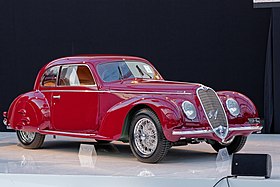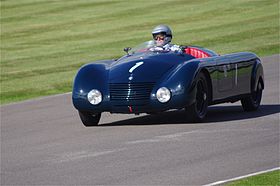Alfa Romeo 6C
| Alfa Romeo 6C | |
|---|---|

1939 Alfa Romeo 6C 2500 Castagna Berlinetta
|
|
| Overview | |
| Manufacturer | Alfa Romeo |
| Production | 1927–1954 |
| Assembly | Portello, Milan, Italy |
| Body and chassis | |
| Class |
Luxury car Sports car Racing car |
| Layout | Front-engine, rear-wheel-drive |
| Powertrain | |
| Engine | Straight-six |
| Chronology | |
| Predecessor | Alfa Romeo RM |
| Successor | Alfa Romeo 1900 |
| Alfa Romeo 6C 1500 | |
|---|---|

6C 1500 Super Sport 1929 from Louwman Collection
|
|
| Overview | |
| Production | 1927–1929 |
| Powertrain | |
| Engine | 1.5 L (1,487 cc) I6 1.5 L (1,487 cc) supercharged I6 |
| Transmission | 4-speed manual |
| Dimensions | |
| Wheelbase |
|
| Alfa Romeo 6C 1750 | |
|---|---|

6C 1750 Super Gran Sport Testa Fissa (1931)
|
|
| Overview | |
| Production | 1929–1933 |
| Body and chassis | |
| Body style | |
| Powertrain | |
| Engine | 1.7 L (1,752 cc) I6 1.7 L (1,752 cc) supercharged I6 |
| Transmission | 4-speed manual |
| Dimensions | |
| Wheelbase |
|
| Alfa Romeo 6C 1900 | |
|---|---|

6C 1900 Gran Turismo at Auto e Moto d'Epoca 2008
|
|
| Overview | |
| Production | 1933 |
| Body and chassis | |
| Body style | 4-door saloon 2-door cabriolet |
| Powertrain | |
| Engine | 1,917 cc DOHC I6 |
| Transmission | 4-speed manual |
| Dimensions | |
| Wheelbase | 2,920 mm (115.0 in) |
| Kerb weight | 1,250 kg (2,756 lb) saloon |
| Alfa Romeo 6C 2300 | |
|---|---|

6C 2300B Touring
|
|
| Overview | |
| Production | 1934–1937 |
| Powertrain | |
| Engine | 2.3 L 2309 cc I6 |
| Alfa Romeo Aerodinamica Spider | |
|---|---|

The Aerodinamica Spider at the 2012 Goodwood Revival
|
|
| Dimensions | |
| Wheelbase | 2,800 mm (110.2 in) |
| Length | 4,750 mm (187.0 in) |
| Width | 1,720 mm (67.7 in) |
| Height | 1,030 mm (40.6 in) |
| Kerb weight | 950 kg (2,094 lb) (dry) |
| Alfa Romeo 6C 2500 | |
|---|---|

6C 2500 Villa d'Este
|
|
| Overview | |
| Production | 1938–1952 |
| Powertrain | |
| Engine | 2.5 L 2443 cc I6 |
| Transmission | 4-speed manual |
| Dimensions | |
| Wheelbase | 3,250 mm (128.0 in) (Turismo) 3,000 mm (118.1 in) (Sport) 2,700 mm (106.3 in) (Super Sport) |
| Chronology | |
| Successor | Alfa Romeo 1900 |

The 6C 3000 CM spider of Museo Storico Alfa Romeo at Goodwood Festival of Speed 2009
|
|
| Constructor | Alfa Romeo |
|---|---|
| Technical specifications | |
| Chassis | Tube spaceframe with backbone |
| Suspension (front) | Double wishbones, coil springs, hydraulic dampers, anti-roll bar |
| Suspension (rear) | De Dion tube, torque arms, coil springs, hydraulic dampers |
| Wheelbase | 2.25 m (88.6 in) (CM) 2.20 m (86.6 in) (PR) |
| Engine | 3,495 cc (213.3 cu in) (CM) 2,943 cc (179.6 cu in) (PR) |
| Transmission | 5-speed, limited slip differential |
| Weight | 960 kg (2,116.4 lb) (CM coupé) 930 kg (2,050.3 lb) (CM spider) 920 kg (2,028.3 lb) (PR) |
| Brakes | Hydraulic, drums, rears inboard |
| Competition history | |
The Alfa Romeo 6C name was used on road, race, and sports cars produced between 1927 and 1954 by Alfa Romeo; the "6C" name refers to six cylinders of the car's straight-six engine. Bodies for these cars were made by coachbuilders such as James Young, Zagato, Touring, Castagna, and Pininfarina. Starting from 1933 there was also a 6C version with a factory Alfa body, built in Portello. In the early 1920s Vittorio Jano got a task to create a lightweight, high performance vehicle to replace the Giuseppe Merosi designed RL and RM models. The car was introduced in April 1925 at the Salone dell’ Automobile di Milano as the 6C 1500. It was based on the P2 racing car, using single overhead cam 1,487 cc inline six-cylinder motor producing 44 horsepower, in the 1928 was presented the 1500 Sport which was the first Alfa Romeo road car with double overhead camshafts.
In the mid-1920s, Alfa's RL was considered too large and heavy, so a new development began. The 2-liter formula that had led to Alfa Romeo winning the Automobile World Championship in 1925, changed to 1.5 liter for the 1926 season. The 6C 1500 was introduced in 1925 at the Milan Motor Show, production started 1927, with the P2 Grand Prix car as starting point. Engine capacity was now 1487 cc, against the P2's 1987 cc, while supercharging was dropped. First versions were bodied by Young and Touring.
In 1928, a 6C Sport was released, with a dual overhead camshafts engine. Its sport version won many races, including the 1928 Mille Miglia. Total production was 3000 (200 with DOHC engine). Ten copies of a supercharged (compressore, compressor) Super Sport variant were also made.
...
Wikipedia
